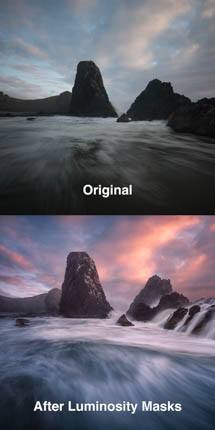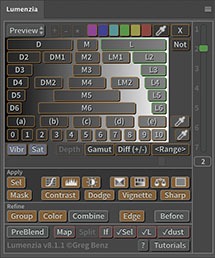Great photography is all about simplifying the scene. It can be so aggravating when a beautiful scene is disrupted by something that has nothing to do with the emotional message you want to convey with your photo, like the white PVC pipe in this scene.
Howard Thompson sent me this image from rural Arkansas asking how he could clean it up. Clone jobs like this get really tricky when you need to work around lots of detailed edges, such as the red farm equipment here untouched. You could spend hours of painstaking work to manually work around these little details, but thankfully luminosity masks offer a faster and more precise way.
Note that if you are using Lumenzia on Photoshop CS6, you should <ctrl/cmd>-click “L” in order to get the same red targeting I got by clicking the red color mode swatch in the video here.
The general workflow is:
- Create a replacement background (duplicate the image and use the clone stamp, healing brush, and patch tools)
- Create a copy of foreground elements (duplicate the image and reveal the foreground through a layer mask). This layer isn’t always required, but helpful when targeting the distraction itself may be challenging. You’ll need a layer mask to reveal the foreground elements and allow the cloned detail to show around it. I used the red color of the foreground here to make the mask by differentiating between the pipe and metal. Every image will have its own unique characteristics, the settings I used here are specific to this image. Try to find what’s most unique about the foreground or background to isolate them.
- Refine the layer masks and cloning as needed. Luminosity selections are an ideal way to deal with any halos or fringing by showing or hiding the layers as appropriate.
However, you’ll need to adapt the workflow to your specific image. Here are a few general guidelines to consider:
- This technique is only as good as the quality of your rough cloning. Try the patch tool for large areas (with generous margins to avoid edge issues). Use the healing brush where you can (it tends to work well for objects you can completely remove, but not very well along remaining edges). Use the clone stamp where the other tools fail (it requires more time and sampling, but avoids the blotchy or discolored results the healing algorithm may create). The new Content-Aware Fill tool is often excellent for large objects.
- I was unable to easily target the white pipe here because it had a full range of tones from bright white to deep shadow, and was also reflecting the surrounding green/red color. However, if you are able to target the distraction well enough, you can skip step #2 above and simply paint white through a luminosity selection onto a white mask in order to reveal the cloning where it is needed.
- Customized selections are critical to getting the precise results you need. In this video, I used two custom luminosity previews. For the first, I created a red mask and brought the white slider in the orange levels all the way in to target the red metal. For the second, I used a L1.5 selection with the red and yellow to the minimum, which helped me target the white pipe.
- Here’s another video some other ways to create custom luminosity selections.
- Using luminosity selections to directly control the clone/heal brush is not typically a good approach. The primary challenge is that you’ll need multiple brush strokes to fully paint the new cloned pixels when working through a luminosity selection. You can do that if you have checked the option to keep the brush aligned. In general, you’ll get better and faster results by creating a rough clone job and then revealing it through a layer mask.

